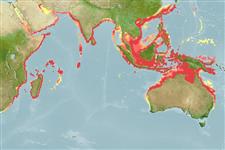Environment: milieu / climate zone / depth range / distribution range
Ökologie
seewasser demersal; tiefenbereich 7 - 200 m (Ref. 4417). Tropical; 30°N - 35°S, 24°E - 154°E
Indian Ocean: throughout the region including the Red Sea and Persian Gulf; south to Algoa Bay in South Africa (Ref. 4417). Western Pacific: Taiwan southward to New Guinea and extending to the northeastern coast of Australia.
Size / Gewicht / Alter
Maturity: Lm ? range ? - ? cm
Max length : 37.5 cm TL Männchen/unbestimmt; (Ref. 117081); common length : 15.0 cm SL Männchen/unbestimmt; (Ref. 9774); max. veröff. Gewicht: 760.00 g (Ref. 117081)
Rückenflossenstacheln (insgesamt) : 0; Rückenflossenweichstrahlen (insgesamt) : 67 - 74; Afterflossenstacheln: 0; Afterflossenweichstrahlen: 52 - 66. Eyed side with dark rings arranged in about 5 longitudinal rows; dark blotch at junction of straight and curved parts of lateral line and 2 smaller ones on the lateral line at posterior part of body and anterior end of caudal peduncle; small dark spots and elongate markings on median fins; pectoral fins with 10-12 rays on eyed side, 10-11 rays on blind side (Ref. 4417).
Found on clay, sand and mud bottoms of the continental shelf. Feeds on benthic animals (Ref. 5213). Mainly sold fresh.
Life cycle and mating behavior
Maturities | Fortpflanzung | Spawnings | Egg(s) | Fecundities | Larven
Distinct pairing (Ref. 205).
Nielsen, J.G., 1984. Bothidae. In W. Fischer and G. Bianchi (eds.) FAO species identification sheets for fishery purposes. Western Indian Ocean fishing area 51. Vol. 1. FAO, Rome. pag. var. (Ref. 3322)
IUCN Rote Liste Status (Ref. 130435)
Bedrohung für Menschen
Harmless
Nutzung durch Menschen
Fischereien: kommerziell
Tools
Zusatzinformationen
Download XML
Internet Quellen
Estimates based on models
Preferred temperature (Ref.
123201): 22.3 - 28.4, mean 26.9 °C (based on 1175 cells).
Phylogenetic diversity index (Ref.
82804): PD
50 = 0.5000 [Uniqueness, from 0.5 = low to 2.0 = high].
Bayesian length-weight: a=0.00692 (0.00537 - 0.00892), b=3.17 (3.12 - 3.22), in cm total length, based on LWR estimates for this species (Ref.
93245).
Trophic level (Ref.
69278): 3.5 ±0.37 se; based on food items.
Generation time: 1.1 ( na - na) years. Estimated as median ln(3)/K based on 1
growth studies.
Widerstandsfähigkeit (Ref.
120179): hoch, Verdopplung der Population dauert weniger als 15 Monate. (Preliminary K or Fecundity.).
Fishing Vulnerability (Ref.
59153): Low vulnerability (19 of 100).
